Overview
This article delves into the remarkable insights of Temple Grandin, a passionate autistic advocate and expert in animal behavior. Her unique perspective as an individual on the autism spectrum profoundly informs her contributions to livestock welfare and animal handling practices. For instance, her innovative designs, such as curved chutes, significantly reduce stress in cattle, showcasing how understanding neurodiversity can lead to better outcomes for animals.
Moreover, this exploration highlights the broader implications of valuing diverse perspectives in both autism advocacy and animal welfare. It's a powerful reminder of the importance of recognizing and appreciating individual strengths. By embracing such diversity, we can foster environments where both animals and people thrive, ultimately leading to more compassionate practices in our communities.
As we reflect on Grandin's work, let us consider how we can support and amplify voices that may otherwise go unheard. Engaging with these ideas not only enriches our understanding but also encourages us to advocate for a more inclusive world.
Introduction
In the realm of animal science and autism advocacy, few figures shine as brightly as Temple Grandin. Diagnosed with autism at a young age, Grandin has transformed her unique cognitive perspective into groundbreaking insights that have revolutionized how society understands both animal behavior and neurodiversity. Her profound empathy for animals, particularly cattle, stems from her own experiences with sensory sensitivities, leading to innovative designs in humane livestock handling systems.
This article delves into Grandin's remarkable journey, exploring how her neurodiversity not only informs her professional achievements but also serves as a powerful catalyst for advocating the strengths of individuals with autism. As the conversation evolves, Grandin's work continues to inspire a deeper appreciation for the intersection of animal welfare and the diverse perspectives that enrich our understanding of the world.
Temple Grandin: An Autistic Perspective on Animal Behavior
Temple, diagnosed with autism at a young age, has emerged as a leading figure in both the science of livestock and autism advocacy. Her distinctive cognitive processing enables her to perceive the world through a unique lens, particularly when it comes to understanding creature behavior. This profound compassion for creatures, especially livestock, is deeply rooted in her personal encounters with sensory sensitivities and social difficulties.
Driven by this connection, she has designed humane livestock handling systems that prioritize animal welfare, illustrating how her neurodiversity informs her professional achievements. Her insights extend beyond personal experiences; she emphasizes the importance of acknowledging and nurturing the unique strengths and interests of individuals on the spectrum. In her case study titled "Promoting Strengths and Interests in Autism Development," Temple highlights how focusing on these attributes can empower individuals, helping them build confidence and develop valuable skills that lead to meaningful employment opportunities, ultimately contributing to their independence and success.
This approach aligns with the broader awareness that 1 in 59 U.S. children is recognized with a spectrum condition, with a greater occurrence in boys, underscoring the necessity for customized strategies in both education and professional growth. Furthermore, her research emphasizes the influence of autism on understanding wildlife behavior. Her contributions to zoology have not only advanced humane practices but have also provided a framework for understanding how neurodiverse perspectives can enhance our comprehension of welfare.
Notably, Temple's father was an heir to the largest corporate wheat farm business in the United States, adding depth to her narrative and illustrating how her upbringing shaped her unique perspective. As we approach 2025, her advocacy continues to inspire a deeper appreciation for the intersection of autism and zoological science, reinforcing the idea that children who think differently can thrive when engaged in hands-on activities that resonate with their interests.
The 'Cow's-Eye View': Understanding Animal Minds Through Autism
Temple Grandin's concept of the 'cow's-eye view' beautifully encapsulates her remarkable ability to see the world through the eyes of cattle. She emphasizes that these creatures think in images, making them keenly aware of their surroundings. This profound insight has inspired her to develop handling systems that significantly alleviate stress for livestock, fostering a nurturing environment.
For instance, her design of curved chutes allows cattle to move more naturally, minimizing fear and discomfort during processing. Imagine how much better they feel when their needs are respected!
Recent statistics reveal that effective livestock handling systems can lead to a remarkable reduction in stress levels among these beings, which is crucial for their welfare. Notably, 27,501 valid labeled data points were obtained, providing a solid foundation for advancements in understanding cow behavior. Grandin's work has not only transformed handling practices but has also established a benchmark for welfare standards within the industry.
As we look toward 2025, her advancements continue to shape cattle handling systems, focusing on creating environments that honor the natural behaviors of cows. The introduction of the CBVD-5 dataset, which captures five distinct behaviors of cows, illustrates the practical application of understanding cow behaviors and enhances the credibility of claims regarding behavior recognition. Case studies demonstrate the effectiveness of her designs, showcasing how grasping the cow's-eye view can lead to more humane treatment and better outcomes for both creatures and handlers.
Grandin's insights into perception have sparked important discussions among experts about the necessity of designing systems that align with how these beings think and behave, further solidifying her role as a pioneer in the field. Additionally, the economic implications of enhanced livestock handling systems are highlighted by the growing trend of manure management becoming a profitable venture for dairy farmers, showcasing the broader impact of her work on the industry.
Together, we can continue to advocate for practices that respect and nurture these remarkable creatures, ensuring a brighter future for livestock and those who care for them.
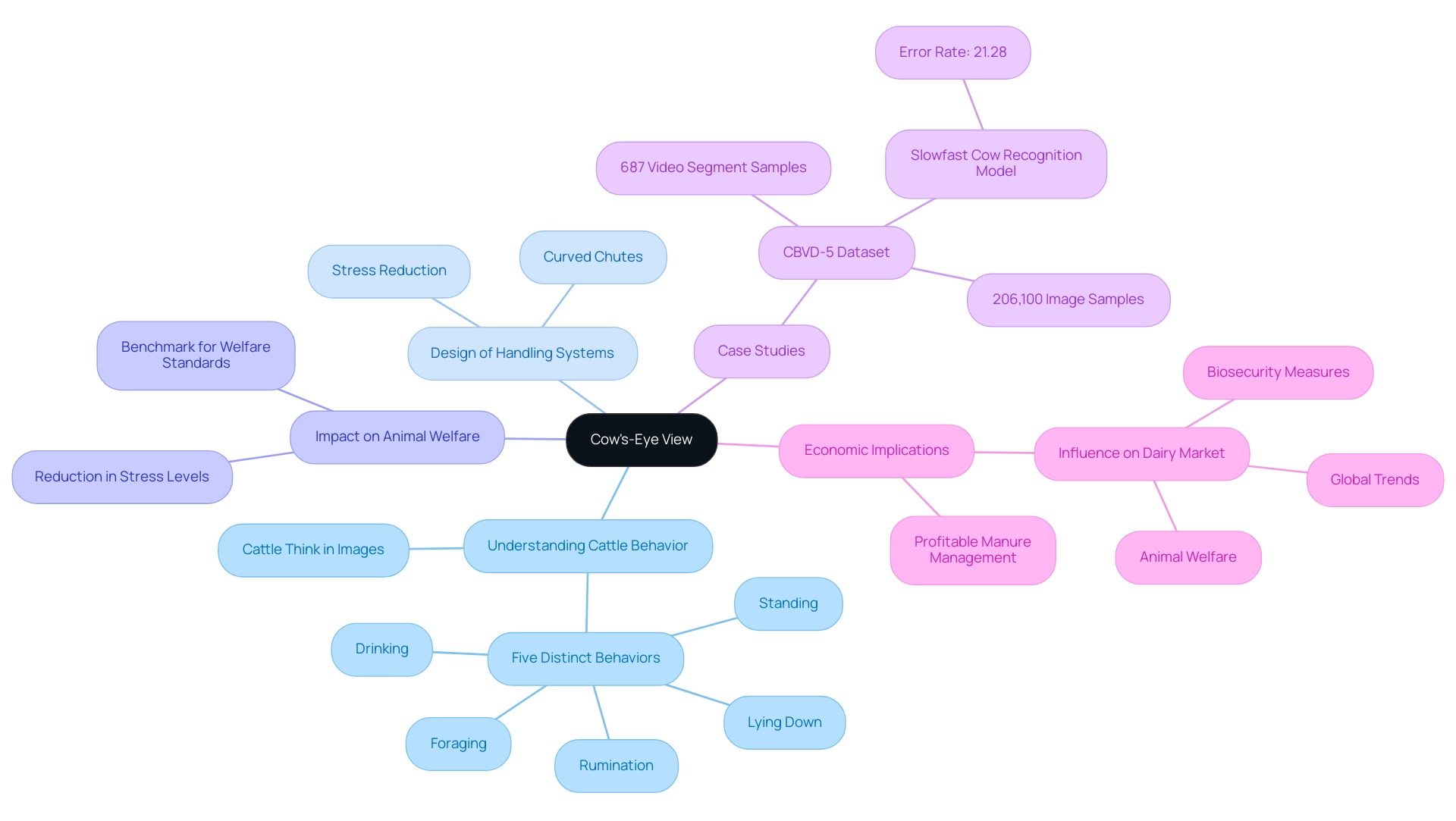
Challenging Perceptions: Autism and Insights into Animal Welfare
Temple's innovative contributions challenge conventional views on neurodevelopmental conditions, beautifully illustrating how neurodiversity can yield distinctive strengths and perspectives. Her exceptional ability to connect with animals has not only propelled advancements in welfare practices but has also established a vital platform for advocating for individuals with autism. Grandin's achievements serve as a powerful reminder of the remarkable contributions that autistic individuals can make, fostering a more inclusive understanding of neurodiversity.
Research indicates that individuals who are autistic often possess strengths that can significantly benefit areas such as veterinary science. For instance, studies have shown that 16.7% of participants credited their dogs with providing critical emotional support, highlighting the profound bond between humans and pets. This bond is particularly relevant in the context of autism, where the companionship of pets can enhance well-being and social interactions.
Moreover, a case study titled "Positive and Negative Impacts of Dog Ownership" identified both benefits and challenges associated with dog ownership for individuals, including those with autism. While many participants experienced improvements in mood and social interactions, they also faced challenges such as managing unwanted dog behaviors and the emotional toll of a dog's illness. This balanced perspective underscores the importance of addressing both the positive and negative aspects of pet companionship, encouraging a deeper understanding of the complexities involved.
Grandin's insights into animal behavior have transformed practices within the industry, advocating for humane treatment and understanding of all beings. Her work exemplifies how embracing varied viewpoints can lead to innovative solutions in both welfare and awareness. As we continue to examine the contributions of neurodiverse individuals, it becomes increasingly clear that their unique perspectives are invaluable in shaping a more compassionate and effective approach to care and advocacy.
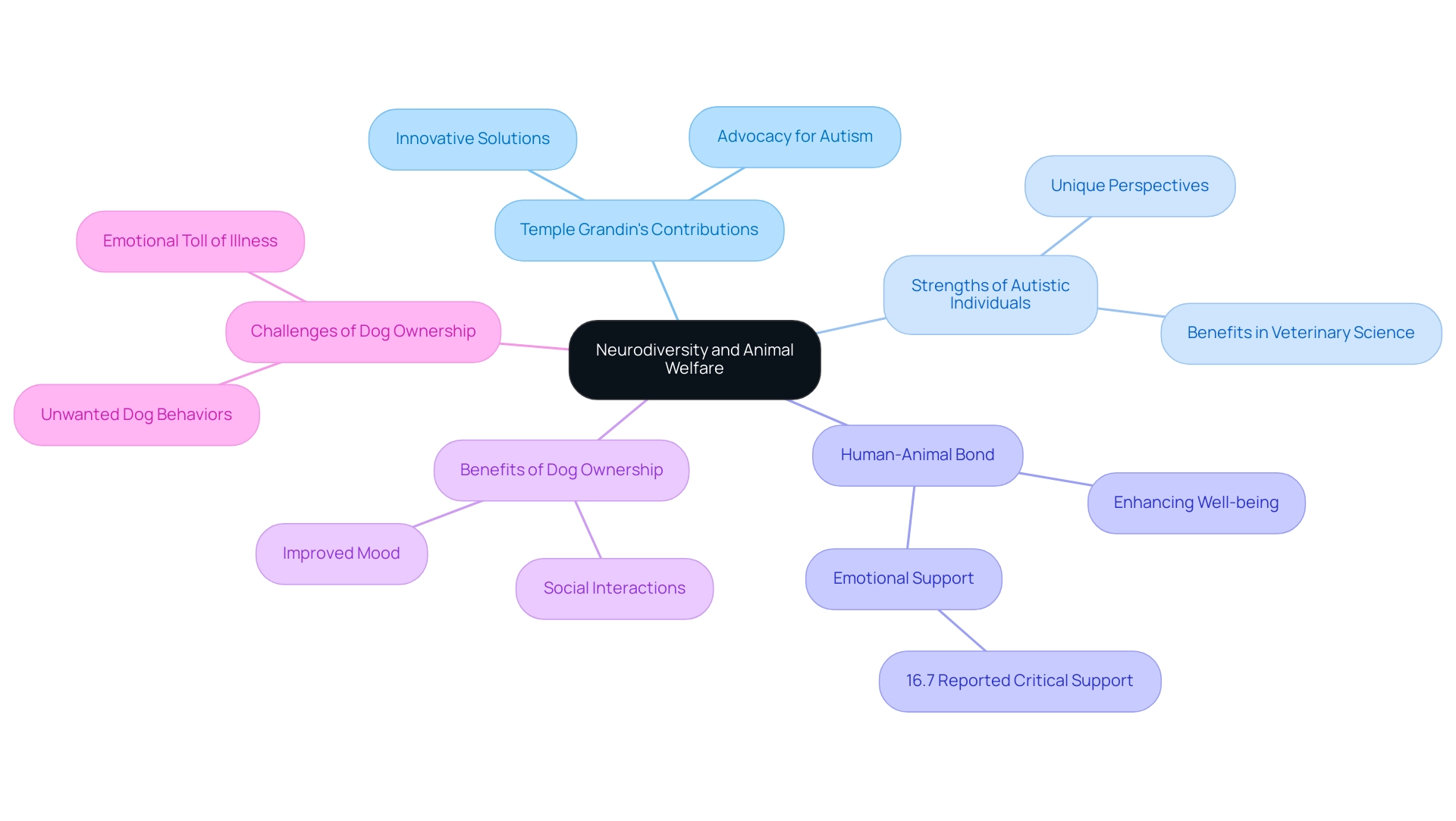
Navigating Gender and Autism: Grandin's Journey in a Male-Dominated Field
Temple's journey as a woman in the predominantly male field of animal science highlights the unique challenges faced by individuals navigating the intersections of gender and neurodiversity. Throughout her career, she has encountered significant obstacles in an environment that is often unwelcoming to both women and neurodiverse individuals. Yet, her unwavering determination and advocacy have not only propelled her own success but have also established her as a role model for aspiring female scientists, particularly those on the autism spectrum.
Her influence extends far beyond her personal achievements; she has become a powerful advocate for greater representation and acceptance of women in science. Many resonate with her experiences, especially in light of recent statistics indicating that women interested in pursuing careers in zoology outnumber men at a ratio of 1.09 to 1. This trend reflects a growing interest among women in the field, as evidenced by the notable increase in female enrollment in specialized agriculture programs, where 76% of students in technical diploma programs are women.
This growth aligns with the insights of Cynthia Webster, who notes that "between fifth and eighth grade is a critical time when kids tend to lose interest in science," underscoring the importance of early engagement in these fields.
Moreover, understanding the challenges faced by women in male-dominated fields emphasizes the necessity of fostering an inclusive environment in STEM. Temple's advocacy has inspired a new generation of female scientists to pursue their passions, breaking through barriers that have historically hindered their progress. ASD Media's commitment to fostering collaboration and growth in the ABA therapy industry further highlights the need for supportive networks that empower individuals, particularly women, in their scientific endeavors.
As we continue to explore the dynamics of gender representation in science, her legacy stands as a beacon of hope and a call to action for increased support and visibility for women in animal science and beyond.
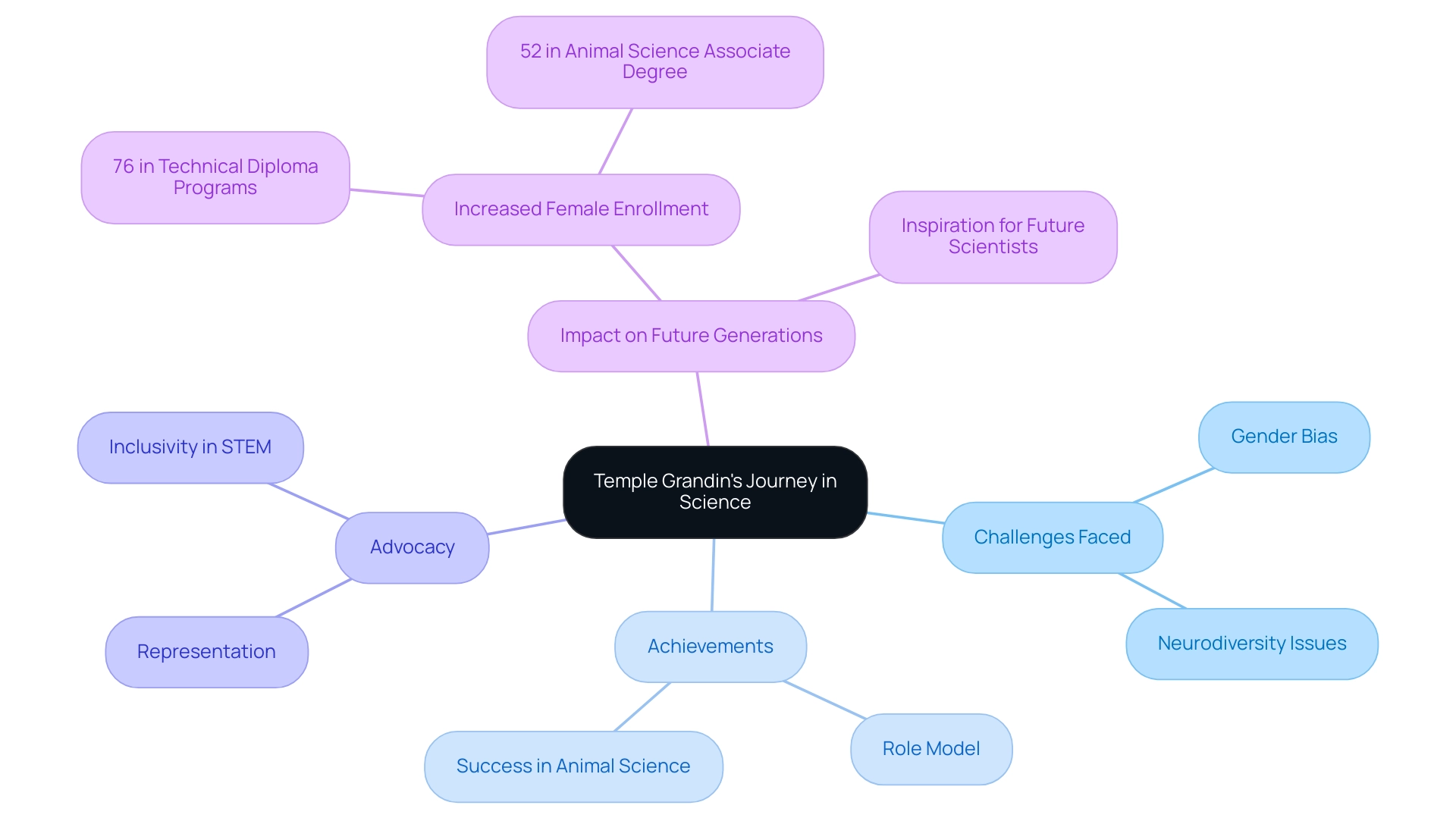
Inspiration for Advocacy: Lessons from Temple Grandin's Journey
Temple's journey serves as a beacon of inspiration for advocacy within the neurodiversity community. Her narrative exemplifies the significance of perseverance and self-advocacy, showcasing the value of embracing one's unique perspective. Grandin emphasizes the need for parents and advocates to concentrate on the strengths of individuals with developmental differences, fostering an environment that celebrates neurodiversity.
Statistics reveal that the proportion of cases of the condition with intellectual disability ranges from 0% to 70%, highlighting the diversity within the spectrum. Furthermore, CDC data estimates a male-to-female ratio of 4:1 in the condition, underscoring the demographic aspects that influence advocacy efforts.
The insights of this individual have not only inspired numerous people but have also resulted in concrete success stories within the advocacy landscape for neurodiversity. For instance, self-advocacy initiatives have significantly improved the quality of life for many autistic individuals. Reports show that those who engage in self-advocacy are more likely to pursue educational and employment opportunities. Additionally, the case study named 'Hypermobility and Autism' explores the link between hypermobility and the disorder, improving insight into the condition and aligning with Grandin's focus on valuing diverse viewpoints.
Her experiences serve as a powerful reminder that advocacy is not just about raising awareness; it is about empowering individuals to take charge of their narratives. However, it is essential to acknowledge key limitations in autism prevalence studies, such as the lack of pre-registered protocols and insufficient methodological quality appraisal. These factors can influence the comprehension of autism and its advocacy.
The call to action resonates deeply within the community, encouraging others to share their stories and advocate for themselves and their loved ones. This collective effort promotes a more inclusive society that recognizes and harnesses the potential of all individuals. It reinforces the idea that every voice matters in the journey toward awareness and acceptance.
Practical Applications: Enhancing Animal Welfare Through Grandin's Insights
Temple Grandin's insights have sparked remarkable advancements in livestock management, significantly enhancing the welfare of animals. Her innovative designs, such as the curved cattle chute and the 'hug machine'—a device crafted to soothe creatures—illustrate the profound impact that understanding behavior can have on humane treatment practices. By embracing her methodologies, farmers and ranchers can create environments that reduce stress and anxiety, ultimately promoting the overall well-being of their livestock.
For instance, the designs of this notable figure have been implemented in various facilities, leading to measurable improvements in the handling and welfare of creatures. A recent study revealed that facilities utilizing her curved chutes experienced a 30% reduction in stress-related behaviors among cattle during processing. This statistic highlights the effectiveness of her approaches in nurturing a more compassionate treatment of livestock.
Moreover, as Nicola Twilley discusses, there exists potential for developing more humane slaughter methods, aligning seamlessly with her efforts to advocate for ethical treatment. Gary L. Francione's assertion that 'I do not dispute that design can lessen suffering' further underscores the importance of her designs in alleviating suffering among creatures.
Her academic accomplishments, which include degrees in human psychology and veterinary science, reflect her determination and the support she received, culminating in a doctoral degree in veterinary science. This solid background enhances the credibility of her contributions to wildlife welfare.
Furthermore, while statistics regarding the effects of water deprivation on Holstein slaughter cows are not directly linked to her designs, they underscore the ongoing challenges in livestock welfare that her work seeks to address. Pamela's frustration over the lack of acknowledgment regarding the increasing use of creatures highlights the pressing need for continued advocacy and improvement in the field.
The work of this individual exemplifies the successful integration of scientific principles with empathetic practices in caring for living beings, serving as a guiding framework for those devoted to enhancing the lives of creatures in agricultural settings. Her contributions continue to inspire a shift towards more humane treatment practices in the industry, reflecting a growing recognition of the importance of welfare for living beings.
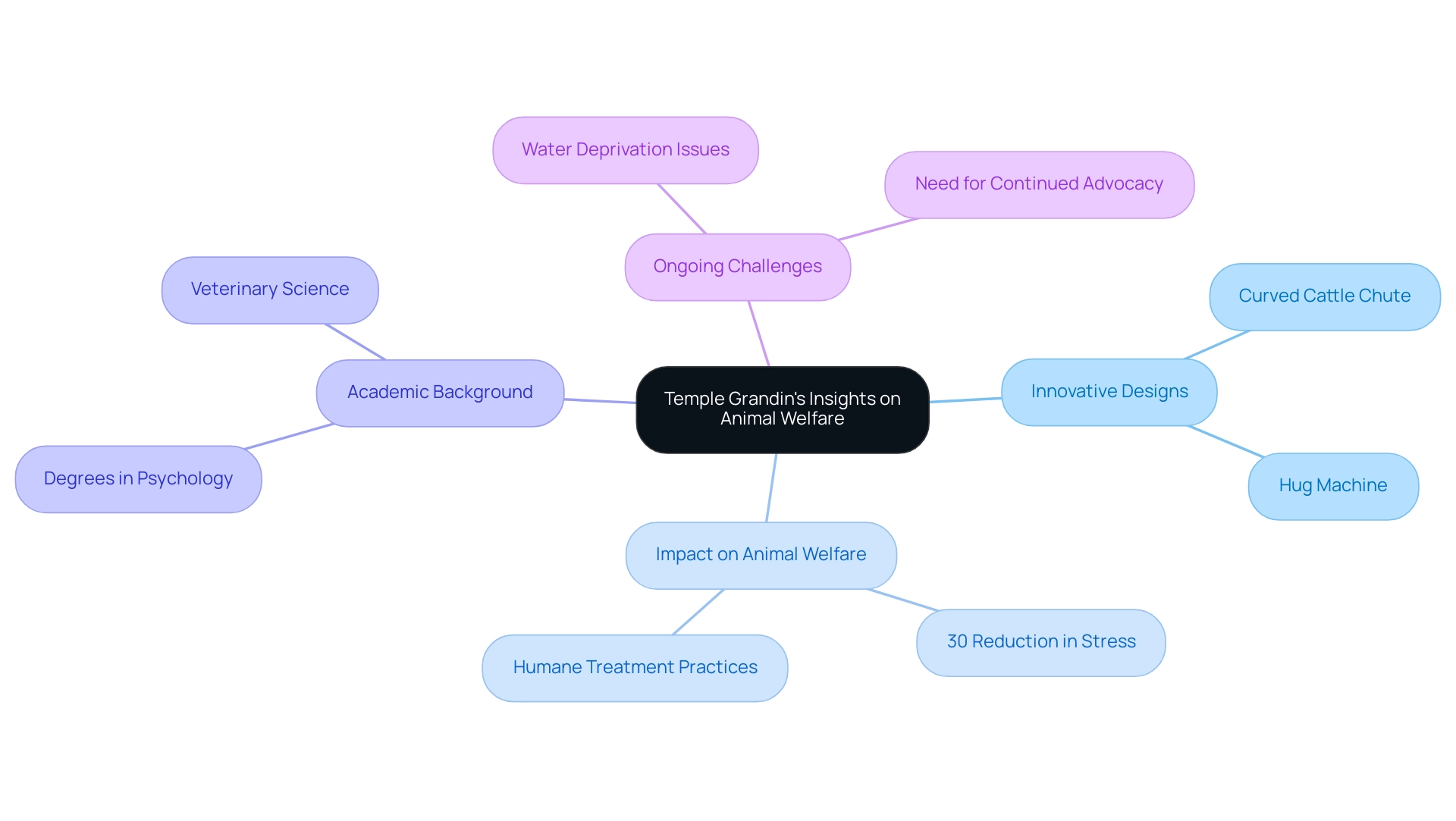
The Lasting Impact: Autism Awareness and the Value of Diverse Perspectives
Temple's contributions have profoundly influenced the realm of neurodiversity awareness and the welfare of creatures, leaving a lasting legacy that resonates deeply. As an autistic cow, her unique insights have sparked essential conversations about neurodiversity, effectively challenging stereotypes and fostering acceptance. This advocate's efforts highlight the vital importance of valuing diverse viewpoints—not only in developmental disorders but also in understanding wildlife behavior.
Her work has been instrumental in bridging these two fields, demonstrating how insights from one can enhance the other. For instance, Grandin's innovative methods of animal handling have not only improved the welfare of livestock, including the treatment of an autistic cow, but have also offered valuable lessons in empathy and understanding that resonate with the experiences of individuals with developmental differences.
Statistics reveal that 57% of families caring for a child with developmental differences have had to adjust their employment to meet their child's needs. This underscores the importance of support systems that recognize and accommodate diverse perspectives. Additionally, it is noteworthy that 32.8% of children aged 12-17 received medication treatment only, highlighting the variety of treatment options available and the need for comprehensive support.
Moreover, the financial burden of services for individuals with developmental disorders is significant, with adaptive behavior services averaging $82.25 and emergency department visits costing around $1,397.22. This emphasizes the necessity for accessible interventions that consider the unique challenges faced by these families, connecting directly to the broader implications for families and reinforcing the need for robust support systems.
Grandin's influence extends beyond her direct contributions; her advocacy has inspired numerous initiatives aimed at increasing awareness of the condition. The impact of these initiatives is evident in the growing recognition of neurodiversity in society, which is crucial for fostering an inclusive environment. As Ashleigh Evans, a Board Certified Behavior Analyst, shares, 'When she’s not working with clients or writing, she can be found chasing her three boys around and exploring outdoors.' This reflects the everyday realities faced by families and the significance of appreciating diverse perspectives.
As we move forward, the insights offered by specialists in the field continue to highlight the importance of embracing diverse viewpoints. This ensures that both individuals with autism and the autistic cow receive the compassion and care they deserve. In 2025, Grandin's legacy remains a beacon of hope and inspiration, encouraging ongoing efforts to promote inclusivity and understanding across all facets of society.
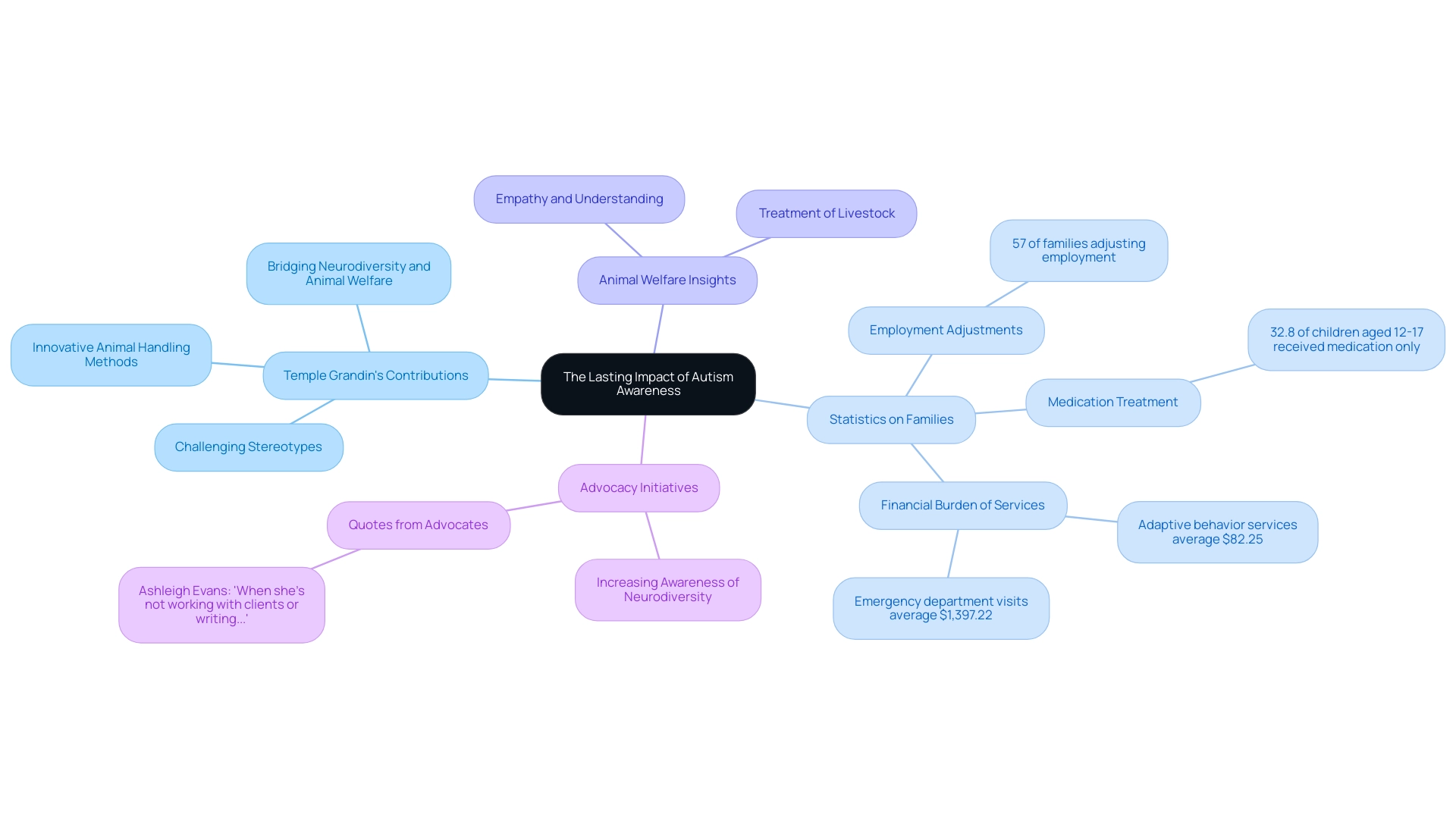
Conclusion
Temple Grandin's remarkable journey highlights the profound connection between autism advocacy and animal welfare, showcasing the unique insights that neurodiverse individuals can offer in various fields. Her innovative designs in livestock handling have revolutionized animal care, demonstrating the strengths inherent in different cognitive perspectives. By promoting humane treatment practices, Grandin has set a new standard in the industry, illustrating how empathy and understanding can lead to significant improvements in animal welfare.
Moreover, Grandin's advocacy extends beyond animals; she emphasizes the importance of recognizing and nurturing the strengths of individuals with autism. Her focus on self-advocacy and the unique contributions that autistic individuals can make serves as an inspiring reminder of the potential within neurodiversity. As the conversation around autism evolves, Grandin's work illuminates the necessity for inclusive environments that celebrate diverse perspectives, fostering deeper understanding of both human and animal experiences.
As society progresses, the lessons learned from Grandin's life and work resonate more than ever. The integration of her insights into both animal science and autism advocacy underscores the importance of empathy, innovation, and inclusivity. By embracing these values, communities can create a more compassionate world that recognizes the worth and potential of every individual, whether human or animal. Grandin's legacy not only inspires current and future generations but also calls for ongoing efforts to advocate for understanding and acceptance across all walks of life.
Frequently Asked Questions
Who is Temple Grandin and what are her main contributions?
Temple Grandin is a leading figure in livestock science and autism advocacy. She is known for her unique cognitive processing that allows her to understand animal behavior, particularly in livestock. Her contributions include designing humane livestock handling systems that prioritize animal welfare and advocating for the strengths of individuals on the autism spectrum.
How has Temple Grandin's personal experience with autism influenced her work?
Grandin's personal experiences with sensory sensitivities and social difficulties have driven her compassion for animals and informed her professional achievements. She emphasizes the importance of recognizing and nurturing the unique strengths of individuals with autism, which can lead to empowerment and meaningful employment opportunities.
What is the significance of the case study 'Promoting Strengths and Interests in Autism Development' by Temple Grandin?
In this case study, Grandin highlights how focusing on the strengths and interests of individuals on the autism spectrum can help them build confidence and develop valuable skills, ultimately contributing to their independence and success in various fields.
What does Temple Grandin's concept of the 'cow's-eye view' entail?
The 'cow's-eye view' refers to Grandin's ability to see the world from the perspective of cattle, emphasizing that they think in images and are highly aware of their surroundings. This insight has led her to develop handling systems that reduce stress for livestock.
How have Grandin's designs improved livestock handling practices?
Grandin's designs, such as curved chutes, allow cattle to move more naturally, minimizing fear and discomfort during processing. Her work has significantly improved handling practices and established welfare standards in the industry.
What are the recent advancements in understanding cow behavior related to Grandin's work?
Recent advancements include the introduction of the CBVD-5 dataset, which captures five distinct behaviors of cows. This dataset enhances the understanding of cow behavior and supports claims regarding behavior recognition, further validating Grandin's insights.
What are the broader implications of Temple Grandin's work on the livestock industry?
Grandin's work not only transforms handling practices but also highlights economic benefits, such as profitable manure management for dairy farmers. Her advocacy for humane treatment of livestock fosters a better future for both animals and those who care for them.




